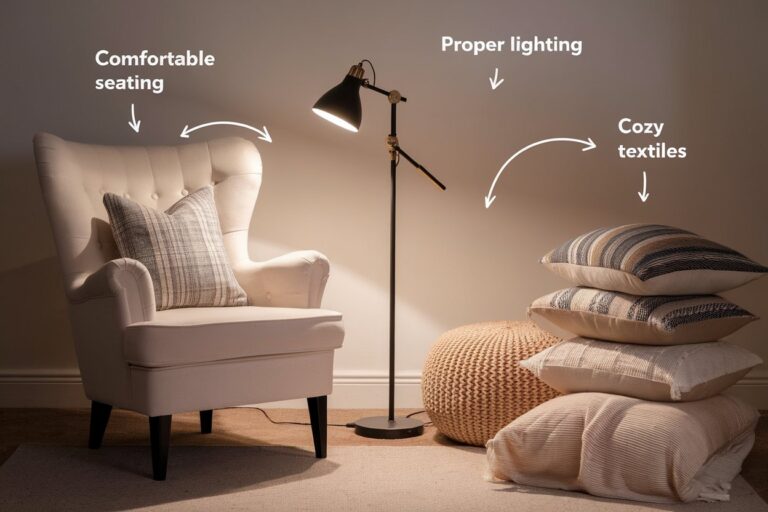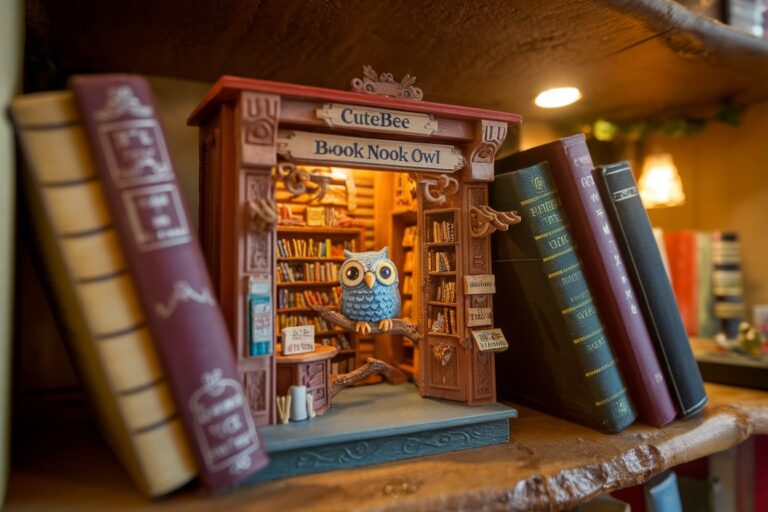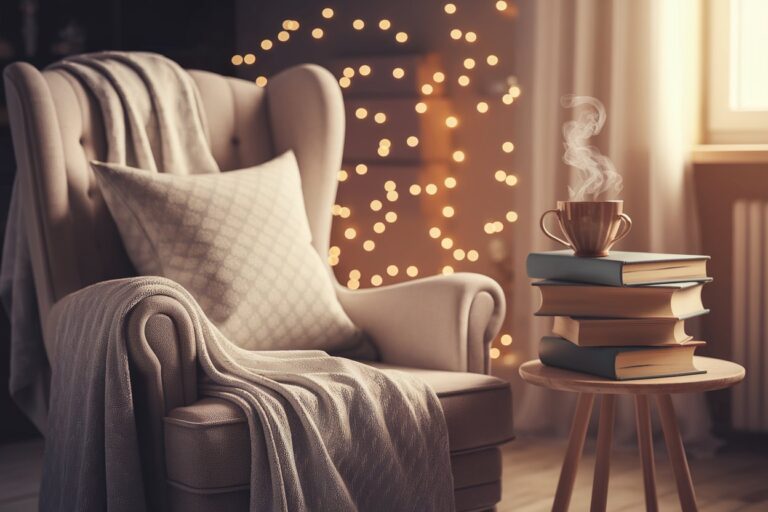Discover 10 utterly novel reading nook ideas to transform any space into a cozy book lover’s retreat. From window seats to bohemian havens, find your perfect reading corner.
There’s something magical about having a special place dedicated solely to getting lost in a good book. As someone who has spent countless hours hunting for the perfect reading spot in my home, I can tell you that creating a designated reading nook changed my relationship with books entirely. No more hunching over on the couch or trying to get comfortable in bed—a proper reading nook provides the perfect escape.
Whether you’re working with a tiny apartment corner or have an entire room to transform, these 10 utterly novel reading nook ideas will help you create a space that’s not just functional but completely enchanting. From budget-friendly DIY solutions to more elaborate setups, there’s something here for every book lover, parent, and DIY enthusiast.
Table of Contents
- What Is a Reading Nook, and Why Is It Important?
- 1. Window Seat Wonder: The Classic Reimagined
- 2. Under-Stairs Hideaway: Maximizing Forgotten Spaces
- 3. Hanging Chair Retreat: A Floating Reading Experience
- 4. Closet Conversion: The Ultimate Cozy Corner
- 5. Outdoor Reading Oasis: Bringing Books Into Nature
- How Can I Create a Cozy Reading Nook in a Small Space?
- 6. Attic Alcove: A Room With Character
- 7. Kids’ Reading Fort: Where Imagination Meets Literature
- 8. Minimalist Reading Corner: Less Is More
- What Are the Essential Elements of a Reading Nook?
- 9. Multi-Purpose Media Nook: For the Digital Reader
- 10. Bohemian Book Haven: Textures and Layers
- How Do I Choose the Best Furniture for a Reading Nook?
- What Lighting Options Work Best for a Reading Nook?
- Are There DIY Ideas for Building a Reading Nook on a Budget?
- Must-Have Items for Your Reading Nook
- How Can I Incorporate Storage Solutions Into My Reading Nook?
- Conclusion: Creating Your Perfect Reading Escape
What Is a Reading Nook, and Why Is It Important?
Before diving into specific ideas, let’s understand what makes a reading nook so special. A reading nook is a dedicated space designed specifically for reading, typically featuring comfortable seating, good lighting, and easy access to books. Unlike general-purpose spaces like living rooms or bedrooms, a reading nook serves one primary function: to create the perfect environment for immersing yourself in literature.
The importance of a dedicated reading space can’t be overstated. In our distraction-filled world, having a place that signals to your brain “This is where we read” helps establish a reading habit. For children, a special reading corner can foster a lifelong love of books. For adults, it provides a much-needed sanctuary from screens and daily stress.
Now, let’s explore 10 utterly novel reading nook ideas that will transform how you experience books.
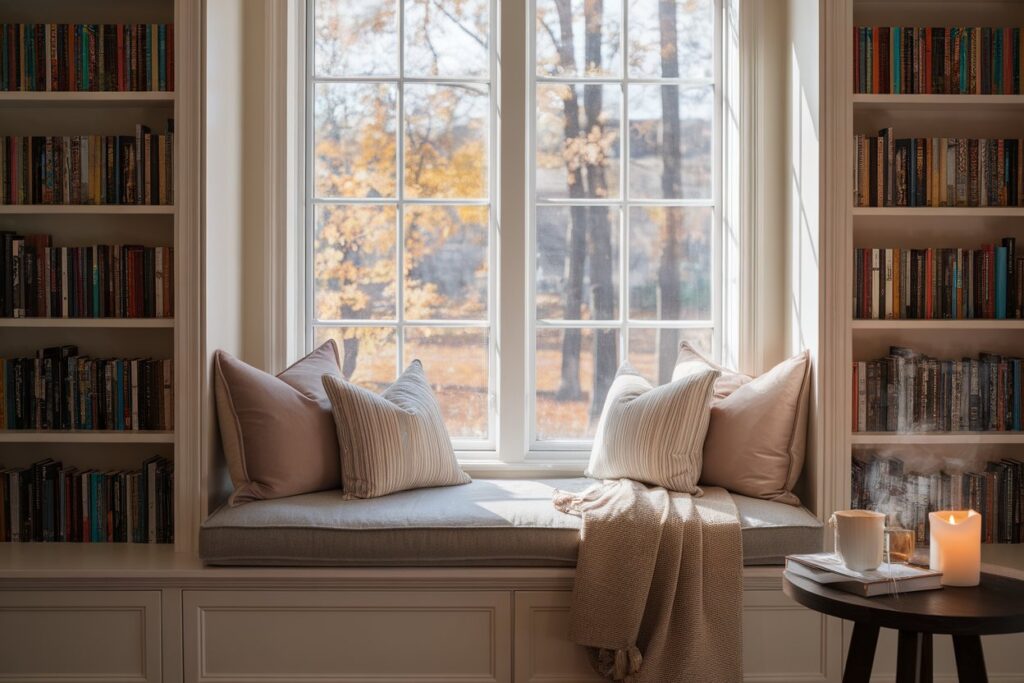
1. Window Seat Wonder: The Classic Reimagined
There’s a reason window seats have been favorite reading spots for centuries—they offer natural light during the day and a connection to the outside world that can enhance your reading experience.
How to create it:
- If you don’t have a built-in window seat, consider placing a bench or daybed under a window
- Add plush cushions in water-resistant fabrics if the area gets direct sunlight
- Include throw pillows for back support
- Install floating shelves on adjacent walls for book storage
- Add a small side table for drinks or reading accessories
I transformed my own bay window into a reading haven with a custom cushion and some weatherproof fabric. Even on rainy days, there’s something incredibly cozy about being tucked away with a book while watching the weather through the glass.
Perfect for: Small spaces, apartments, and those who love natural light
Cost range: $200-$1,000 depending on whether you DIY or hire professionals
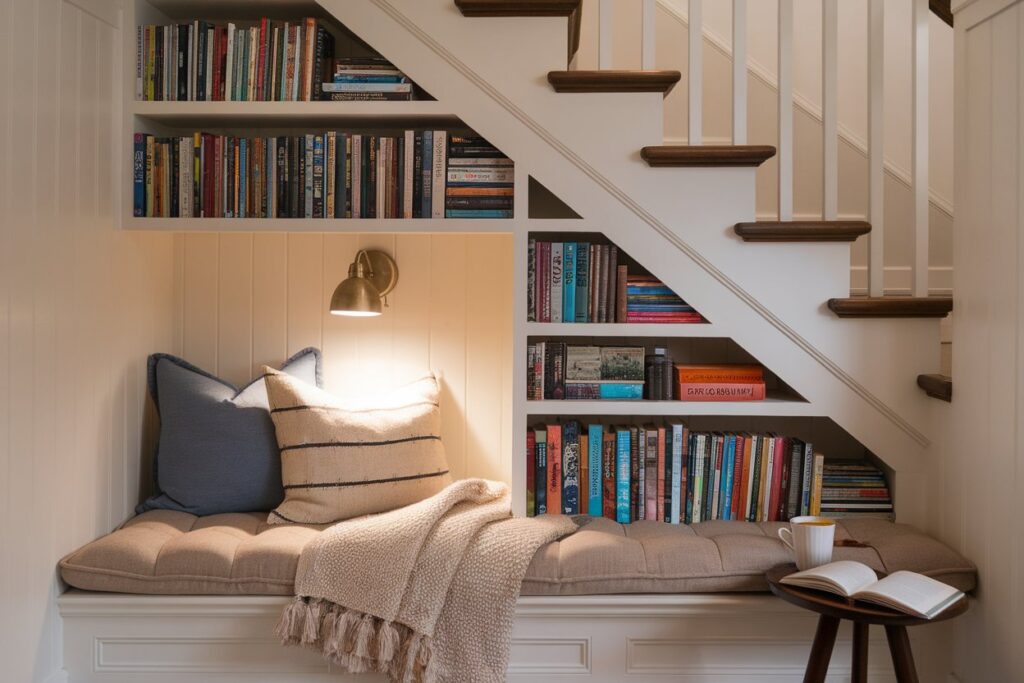
2. Under-Stairs Hideaway: Maximizing Forgotten Spaces
That awkward space under your staircase doesn’t have to be wasted on storage. With some creativity, it can become one of the most charming reading nooks in your home.
How to create it:
- Clear out the under-stairs area and measure the dimensions
- Install basic framing if needed
- Add a custom-cut mattress or cushion that fits the space perfectly
- Install recessed lighting or a small reading lamp
- Build-in shelving along the sides or back wall
- Add curtains for privacy and a touch of magic
The beauty of an under-stairs nook is that it feels like a secret hideaway. My friend transformed her under-stairs space with some basic carpentry skills, creating a Harry Potter-inspired nook that her kids absolutely adore.
Perfect for: Families with children, fantasy book lovers, homes with underutilized stair space
Cost range: $300-$800 for DIY, $1,000-$2,500 for professional installation
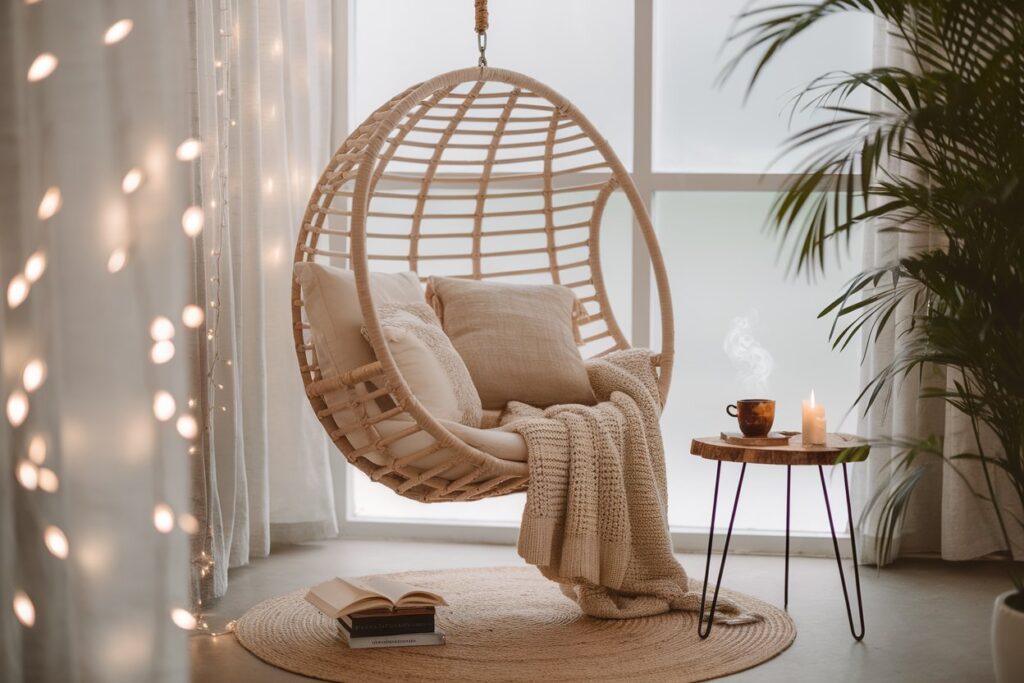
3. Hanging Chair Retreat: A Floating Reading Experience
For a truly novel approach to reading nooks, consider taking your reading off the ground entirely. Hanging chairs or indoor swings create a gentle rocking motion that many readers find soothing.
How to create it:
- Ensure your ceiling can support a hanging chair (consult a professional if unsure)
- Choose between macramé, rattan, or modern designs based on your style
- Install the chair with the proper hardware
- Add plush pillows and a soft throw blanket
- Position a floor lamp nearby for optimal lighting
- Include a small side table or basket for books
I was skeptical about reading in a hanging chair until I tried my friend’s Anthropologie-inspired setup. The gentle swaying motion actually helped me focus better on my book, and it became an instant conversation piece whenever guests visited.
Perfect for: Modern homes, boho-inspired décor, TikTok-worthy spaces, readers who like movement
Cost range: $150-$600 depending on chair quality and installation needs
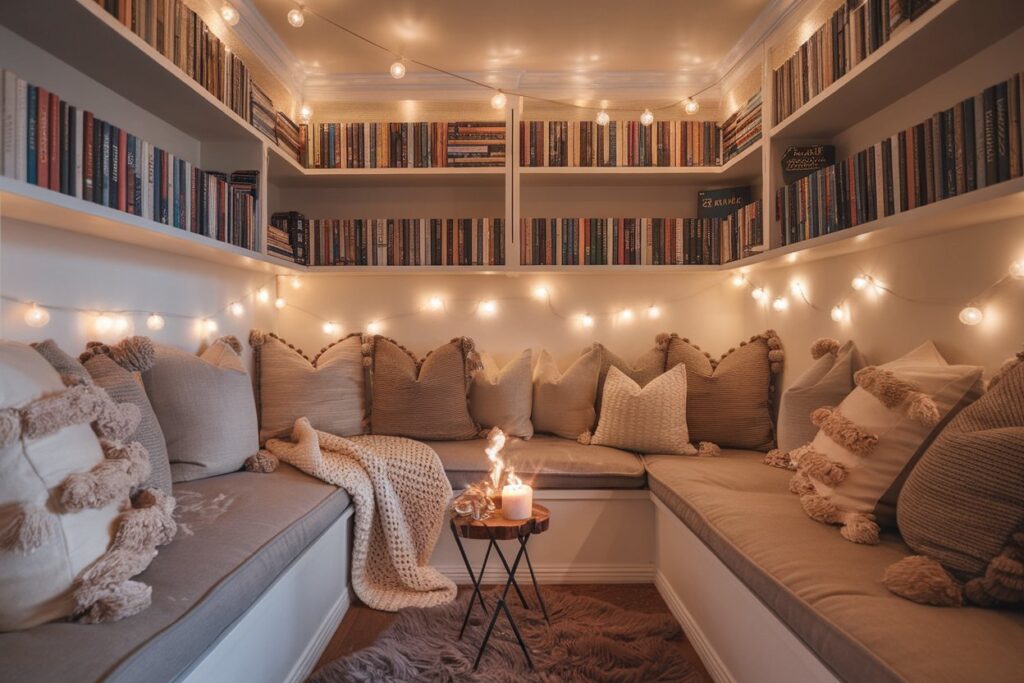
4. Closet Conversion: The Ultimate Cozy Corner
If you have a spare closet or one that’s inefficiently used, consider transforming it into what might become your favorite reading spot in the house.
How to create it:
- Remove closet doors (or keep them for a truly hidden retreat)
- Take out clothing rods and shelves
- Add a bench seat or cushion that fits wall-to-wall
- Install battery-operated or plug-in lighting
- Line the walls with wallpaper or paint in a contrasting color
- Add floating shelves above the seating area
- Hang string lights or LED strips for ambiance
I converted a small linen closet in my hallway into a reading nook, and it’s become my favorite place to escape. The enclosed nature makes it perfect for those who want to feel completely removed from the rest of the house.
Perfect for: Small apartments, minimalists, those seeking maximum coziness
Cost range: $100-$400 depending on materials and current closet condition
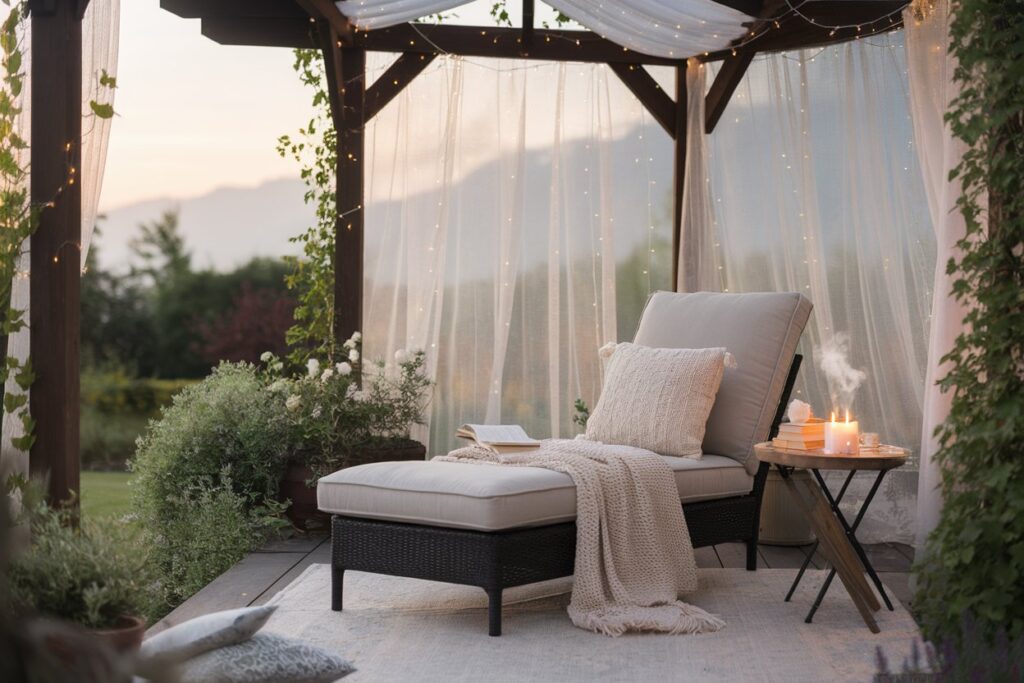
5. Outdoor Reading Oasis: Bringing Books Into Nature
Who says reading nooks have to be indoors? Creating a dedicated reading space in your yard, balcony, or patio can provide a refreshing alternative to indoor reading.
How to create it:
- Choose a location with partial shade or add a canopy/umbrella
- Select weather-resistant furniture (consider an outdoor daybed or deep-seated chair)
- Add outdoor cushions and pillows in water-resistant fabrics
- Install solar-powered lighting for evening reading
- Include a small weatherproof container or cabinet for storing books during visits
- Add potted plants for greenery and privacy
My small apartment balcony became a surprisingly perfect reading retreat with just a comfortable chair, some string lights, and potted plants for privacy from neighbors. On nice days, it’s actually more appealing than any indoor spot.
Perfect for: Nature lovers, those with outdoor space, summer reading sessions
Cost range: $200-$1,000 depending on furniture quality and existing outdoor space
How Can I Create a Cozy Reading Nook in a Small Space?
Limited square footage doesn’t mean you have to give up on your dreams of a dedicated reading area. Small spaces often make the coziest nooks! Here are some tips specifically for compact areas before we continue with our list:
- Focus on vertical storage with tall, narrow bookshelves
- Use corners effectively—corner seating can maximize awkward spaces
- Consider furniture that serves multiple purposes, like storage ottomans
- Use light colors to make the space feel larger
- Employ mirrors to create the illusion of more space
- Keep décor minimal to avoid visual clutter
Now, let’s continue with more innovative reading nook ideas!
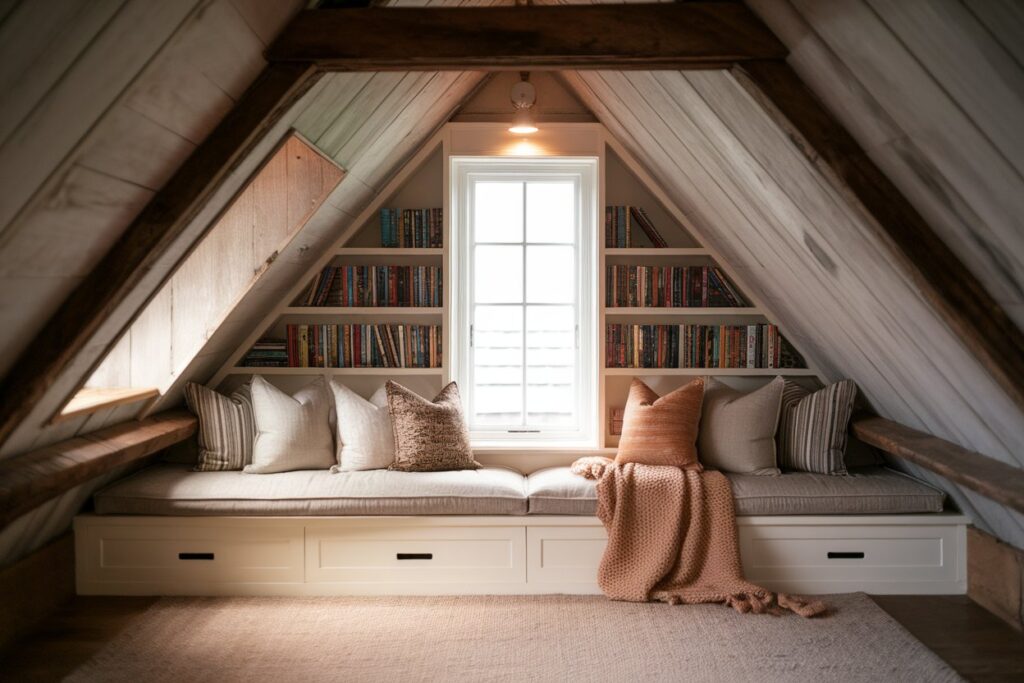
6. Attic Alcove: A Room With Character
Attic spaces often go underutilized, but their unique architecture—sloped ceilings, dormer windows, exposed beams—creates the perfect backdrop for a charming reading retreat.
How to create it:
- Clean and insulate the space if needed
- Add proper flooring or a large area rug
- Position seating near natural light sources like dormer windows
- Install wall sconces to save floor space
- Use the sloped walls for built-in or floating shelving
- Add soft textiles like throw pillows and blankets to soften the angular space
I helped a friend transform her attic space into a reading nook, and the sloped ceiling actually created this wonderful cocoon-like feeling that made reading feel extra special.
Perfect for: Homes with accessible attic space, fans of unique architecture, and those wanting a more private retreat
Cost range: $300-$2,000 depending on current attic condition and needed renovations
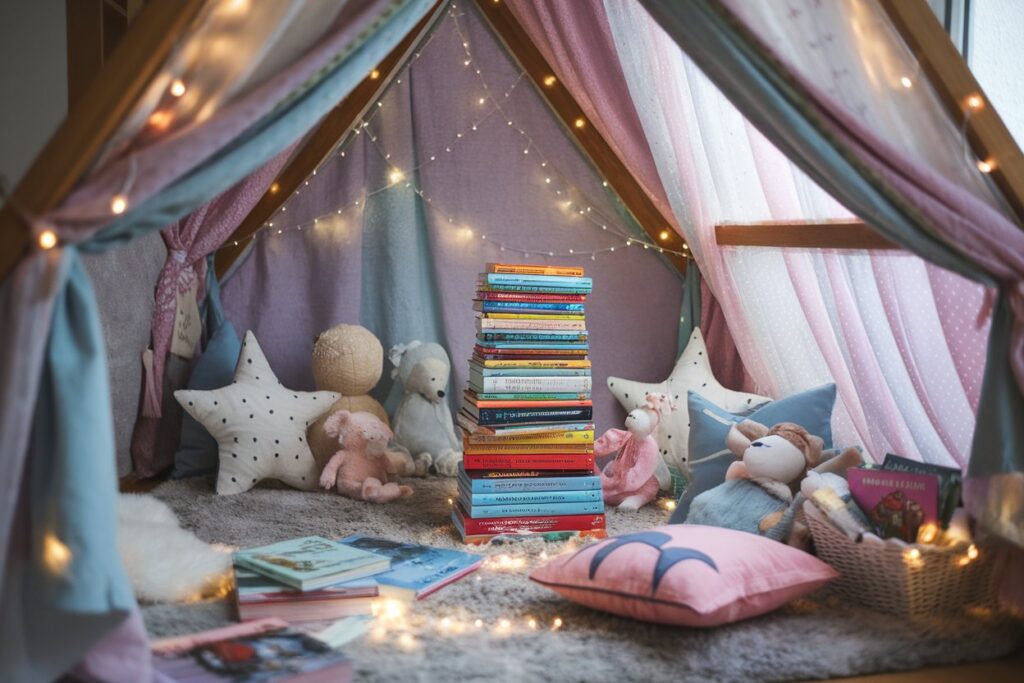
7. Kids’ Reading Fort: Where Imagination Meets Literature
Creating a special reading nook for children can foster a lifelong love of reading by associating books with fun, comfort, and imagination.
How to create it:
- Start with a base structure—this could be a teepee tent, canopy, repurposed playhouse, or even a loft bed with space underneath
- Add soft flooring with play mats, rugs, or cushions
- Include plenty of pillows and stuffed animal “reading buddies.”
- Incorporate theme elements based on favorite books (Harry Potter, Narnia, etc.)
- Install string lights or a child-safe lamp for proper lighting
- Add low bookshelves or book bins that kids can access themselves
- Include a small table or lap desk for activity books
When I created a simple canopy reading nook for my niece, complete with twinkle lights and her favorite characters, her reading time increased dramatically. The space made books feel special and exciting.
Perfect for: Families with young children, teachers creating classroom reading corners
Cost range: $100-$500 depending on materials and complexity
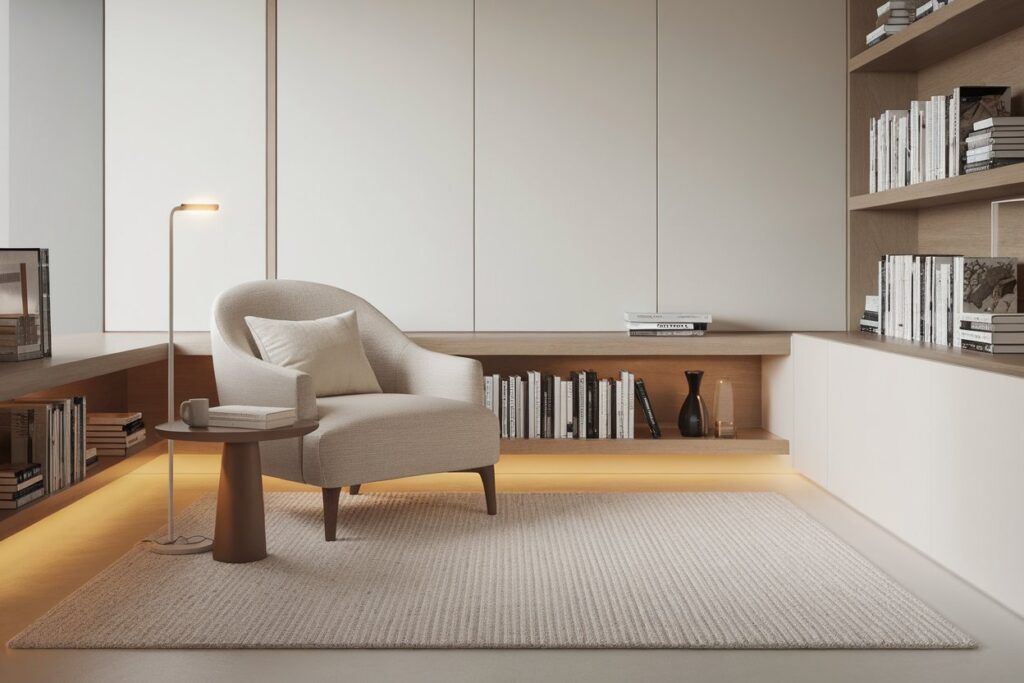
8. Minimalist Reading Corner: Less Is More
In contrast to more elaborate setups, a minimalist reading nook focuses on just the essentials: comfortable seating, good lighting, and easy access to books—nothing more, nothing less.
How to create it:
- Choose a single, high-quality reading chair in a neutral color
- Add one perfect reading lamp with adjustable brightness
- Include a small side table for essentials only
- Install floating shelves in a grid pattern for a clean book display
- Keep color palette limited (whites, blacks, grays, natural woods)
- Add just one or two decorative elements, like a plant or artwork
- Ensure the space is free from clutter and distractions
My own reading corner went from cluttered to calming when I embraced minimalist principles. By removing everything that wasn’t essential to the reading experience, I found I could focus better on my books.
Perfect for: Small spaces, minimalists, those easily distracted by visual clutter
Cost range: $300-$800 for quality essentials
What Are the Essential Elements of a Reading Nook?
While reading nooks can vary greatly in style and size, certain elements are crucial for functionality and comfort:
- Comfortable seating – Whether it’s a chair, bench, or pile of floor cushions, comfort is non-negotiable
- Proper lighting – Natural light is ideal for daytime reading, while adjustable artificial lighting is essential for evenings
- Book storage – Easy access to your current reads and favorites
- Surface space – A small table or shelf to hold a drink, bookmark, or reading glasses
- Cozy textiles – Pillows, throws, and soft surfaces make the experience more inviting
Let’s continue with our final two novel reading nook ideas!
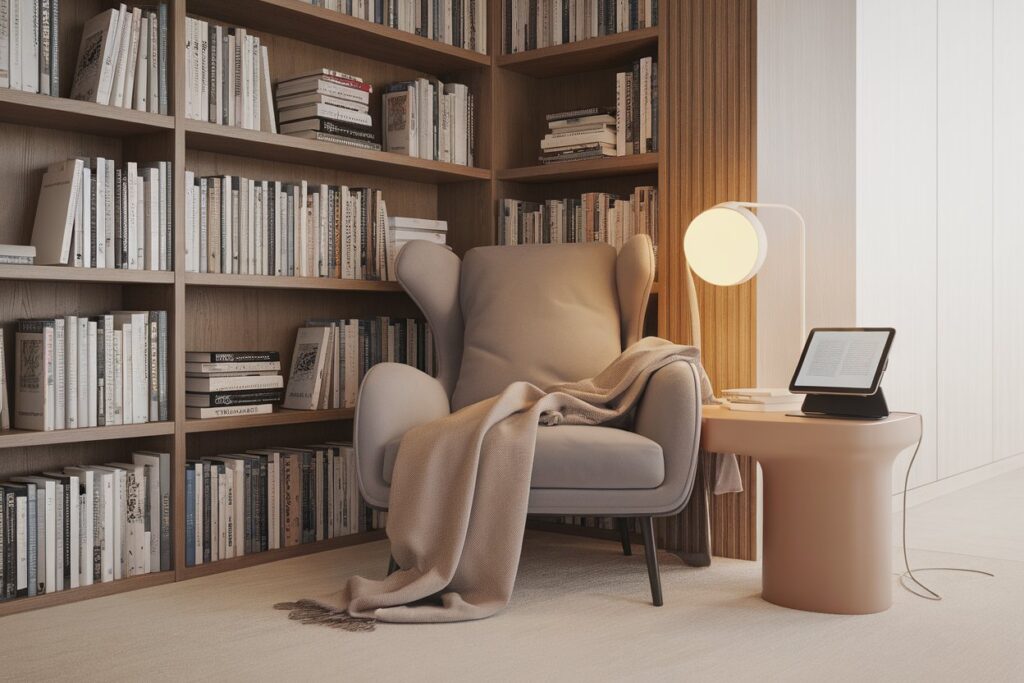
9. Multi-Purpose Media Nook: For the Digital Reader
For those who enjoy both physical books and e-readers or audiobooks, a tech-friendly reading nook can combine the best of both worlds.
How to create it:
- Choose a comfortable chair with good back support for longer sessions
- Include accessible power outlets or a charging station
- Add adjustable lighting that reduces screen glare
- Install a wall-mounted tablet holder or adjustable desk arm
- Include noise-canceling headphones for audiobook listening
- Create storage for both physical books and digital devices
- Consider a small sound system for background music or nature sounds
I’ve found that having a dedicated spot for both my physical books and my e-reader has actually increased my reading time. When I’m too tired to hold a book, I can switch to my e-reader or audiobook without leaving my cozy spot.
Perfect for: Tech-savvy readers, audiobook fans, and those with vision challenges
Cost range: $400-$1,000 depending on technology needs
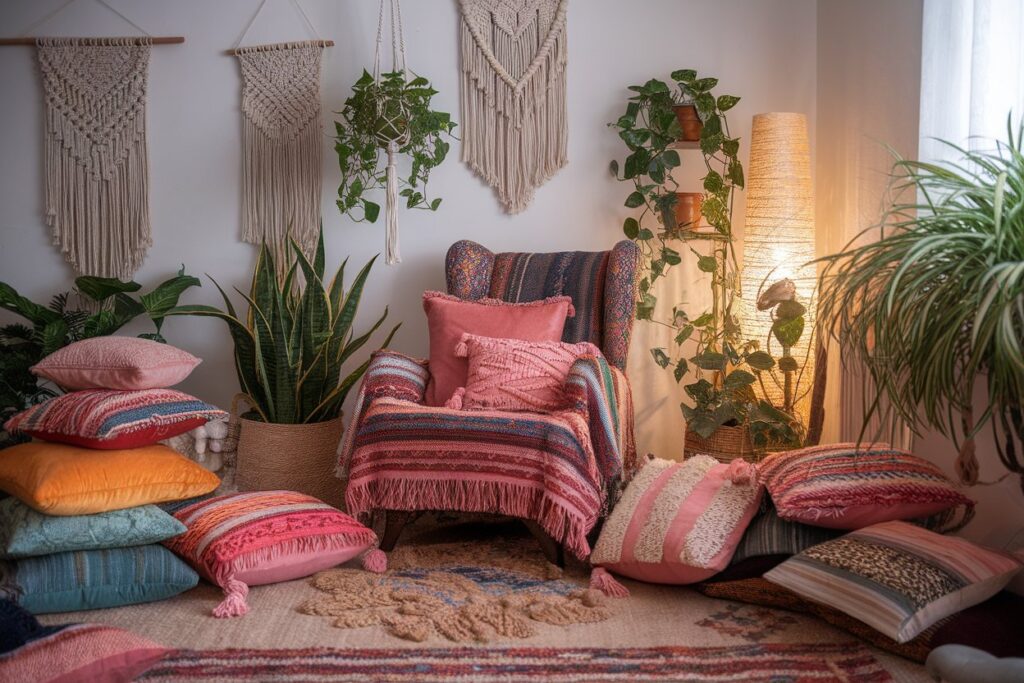
10. Bohemian Book Haven: Textures and Layers
For those who want their reading nook to double as a statement piece, a bohemian-inspired setup creates a visually stunning retreat that’s as comfortable as it is beautiful.
How to create it:
- Start with a base of floor cushions, a low couch, or a daybed
- Layer multiple textiles—think Moroccan rugs, macramé wall hangings, embroidered pillows
- Add various cushions in different shapes, sizes, and complementary patterns
- Incorporate plants of varying heights and textures
- Use natural materials like rattan, bamboo, and jute
- Add ambient lighting through string lights, paper lanterns, or Moroccan-inspired lamps
- Include baskets for book storage that add to the overall aesthetic
When I embraced the bohemian style for my reading corner, it transformed not just my reading experience but the entire feel of my living room. The layered textiles make it incredibly comfortable for long reading sessions.
Perfect for: Creative personalities, those who prioritize aesthetics, fans of maximalist décor
Cost range: $200-$800 depending on existing furniture and textile choices
How Do I Choose the Best Furniture for a Reading Nook?
The right furniture can make or break your reading nook. Here are some considerations when selecting pieces for your space:
- Seating comfort: Test before buying if possible; look for good back support and cushioning
- Size appropriateness: Measure your space carefully to ensure furniture fits properly
- Material durability: Consider how the furniture will hold up to regular use
- Style consistency: Choose pieces that complement your existing décor
- Versatility: Multi-functional pieces work best in smaller spaces
- Reading position: Consider how you prefer to read (upright, reclined, etc.) when selecting seating
| bohemian-style reading corner | Best For | Considerations |
|---|---|---|
| Armchair | Bohemian-style reading corner | Look for cushioned arms and good lower back support |
| Chaise Lounge | Those who prefer to recline | Ensure length accommodates your height |
| Window Bench | Small spaces with good natural light | Add cushions for comfort on harder surfaces |
| Floor Cushions | Casual readers, kids’ spaces | Layer multiple cushions for adequate support |
| Hanging Chair | Modern spaces, movement lovers | Verify weight capacity and ceiling strength |
| Daybed | Readers who like to fully stretch out | Consider width based on available space |
What Lighting Options Work Best for a Reading Nook?
Proper lighting prevents eye strain and enhances the reading experience. Here are the best options:
- Natural light: Position your nook near windows when possible
- Task lighting: Directed light specifically for reading (floor lamps, table lamps, clip-on lights)
- Ambient lighting: Background illumination for atmosphere (string lights, wall sconces)
- Adjustable options: Lamps with dimmer switches or multiple settings
- Color temperature: Warm lighting (2700-3000K) for cozy feel, cooler lighting (4000-5000K) for better visibility
For my own reading nook, I found that layering different light sources—a window for daytime, an adjustable floor lamp for evenings, and some string lights for ambiance—created the perfect lighting for any time of day.
Are There DIY Ideas for Building a Reading Nook on a Budget?
Creating a reading nook doesn’t have to break the bank. Here are some budget-friendly approaches:
- Repurpose existing furniture like benches, daybeds, or comfortable chairs
- Use crates or wooden pallets to create custom seating with added cushions
- Construct simple floating shelves from inexpensive lumber
- Visit thrift stores for unique furniture pieces that can be refurbished
- Make your own pillows and cushions with basic sewing skills
- Use removable wallpaper for accent walls instead of permanent renovation
- Create lighting with string lights, battery-operated options, or repurposed lamps
- Utilize fabric remnants for custom curtains or canopies
I created my first reading nook for under $150 using a secondhand chair, some discount store pillows, and wall shelves made from reclaimed wood. The budget didn’t limit the coziness factor one bit!
Must-Have Items for Your Reading Nook
To elevate your reading experience, consider adding these essential items to your shopping list:
| Product Type | Why It’s Essential | Recommendation |
|---|---|---|
| Comfortable Chair | Foundation of any reading nook | Plush armchair with good back support |
| Reading Light | Prevents eye strain | Adjustable floor lamp with multiple brightness levels |
| Soft Throw Blanket | The foundation of any reading nook | Faux fur throw in a neutral color |
| Supportive Pillows | Allows for varied reading positions | Memory foam wedge pillow for back support |
| Side Table | Holds drinks and reading accessories | Compact side table with storage shelf |
| Bookshelf/Storage | Keeps reading material accessible | Floating wall shelves to save floor space |
| Soft Rug | Defines the space and adds comfort | Natural fiber rug with subtle pattern |
| Noise Solution | Minimizes distractions | Noise-canceling headphones or small white noise machine |
How Can I Incorporate Storage Solutions Into My Reading Nook?
Effective storage keeps your reading materials accessible while maintaining an organized space:
- Install floating shelves above or beside seating
- Use storage ottomans that double as footrests
- Incorporate bench seating with hinged tops or drawers underneath
- Add baskets or bins that complement your décor
- Install pocket organizers on the sides of upholstered furniture
- Use vertical magazine racks for periodicals
- Create a rolling cart system that can be moved as needed
- Build custom built-ins if space allows
In my small apartment, I found that thinking vertically with wall-mounted shelving freed up floor space while keeping my books organized and accessible.
Conclusion: Creating Your Perfect Reading Escape
Whether you’re a parent looking to encourage your child’s reading habit, a book lover seeking your own sanctuary, or a DIY enthusiast ready for a new project, creating a reading nook is a worthwhile investment in your home and well-being.
The perfect reading nook doesn’t require an enormous space or budget—just thoughtful consideration of your reading habits and style preferences. Start with the essentials: comfortable seating, good lighting, and easy access to books. From there, personalize the space to reflect your personality and enhance your reading experience.
Remember that your reading nook should evolve with you. As you discover what enhances your reading experience, don’t be afraid to make adjustments. The most important quality of any reading nook is that it calls to you, inviting you to sit down, open a book, and lose yourself in a story.
Which of these reading nook ideas speaks to you? Start planning your perfect reading space today, and share your creations with fellow book lovers to inspire their own cozy corners.

